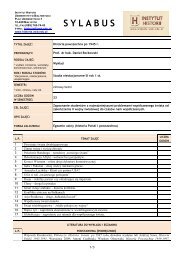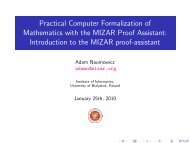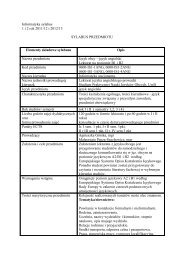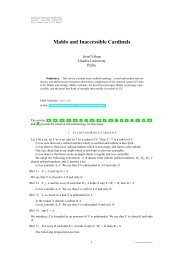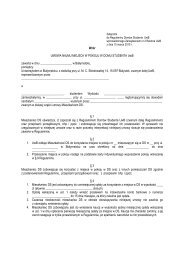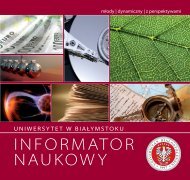Functions and Finite Sequences of Real Numbers
Contents - Markun Cs Shinshu U Ac Jp
Contents - Markun Cs Shinshu U Ac Jp
- No tags were found...
Create successful ePaper yourself
Turn your PDF publications into a flip-book with our unique Google optimized e-Paper software.
JOURNAL OF FORMALIZED MATHEMATICS<br />
Volume 5, Released 1993, Published 2003<br />
Inst. <strong>of</strong> Computer Science, Univ. <strong>of</strong> Białystok<br />
<strong>Functions</strong> <strong>and</strong> <strong>Finite</strong> <strong>Sequences</strong> <strong>of</strong> <strong>Real</strong> <strong>Numbers</strong><br />
Jarosław Kotowicz<br />
Warsaw University<br />
Białystok<br />
Summary. We define notions <strong>of</strong> fiberwise equipotent functions, non-increasing finite<br />
sequences <strong>of</strong> real numbers <strong>and</strong> new operations on finite sequences. Equivalent conditions for<br />
fiberwise equivalent functions <strong>and</strong> basic facts about new constructions are shown.<br />
MML Identifier: RFINSEQ.<br />
WWW: http://mizar.org/JFM/Vol5/rfinseq.html<br />
The articles [11], [14], [12], [15], [4], [5], [3], [1], [9], [2], [10], [13], [7], [6], <strong>and</strong> [8] provide the<br />
notation <strong>and</strong> terminology for this paper.<br />
Let F, G be binary relations. We say that F <strong>and</strong> G are fiberwise equipotent if <strong>and</strong> only if:<br />
(Def. 1)<br />
For every set x holds F −1 ({x}) = G −1 ({x}).<br />
Let us notice that the predicate F <strong>and</strong> G are fiberwise equipotent is reflexive <strong>and</strong> symmetric.<br />
We now state several propositions:<br />
(1) For all functions F, G such that F <strong>and</strong> G are fiberwise equipotent holds rngF = rngG.<br />
(2) Let F, G, H be functions. Suppose F <strong>and</strong> G are fiberwise equipotent <strong>and</strong> F <strong>and</strong> H are<br />
fiberwise equipotent. Then G <strong>and</strong> H are fiberwise equipotent.<br />
(3) Let F, G be functions. Then F <strong>and</strong> G are fiberwise equipotent if <strong>and</strong> only if there exists a<br />
function H such that domH = domF <strong>and</strong> rngH = domG <strong>and</strong> H is one-to-one <strong>and</strong> F = G·H.<br />
(4) For all functions F, G holds F <strong>and</strong> G are fiberwise equipotent iff for every set X holds<br />
F −1 (X) = G −1 (X).<br />
(5) Let D be a non empty set <strong>and</strong> F, G be functions. Suppose rngF ⊆ D <strong>and</strong> rngG ⊆ D. Then<br />
F <strong>and</strong> G are fiberwise equipotent if <strong>and</strong> only if for every element d <strong>of</strong> D holds F −1 ({d}) =<br />
G −1 ({d}).<br />
(6) Let F, G be functions. Suppose domF = domG. Then F <strong>and</strong> G are fiberwise equipotent if<br />
<strong>and</strong> only if there exists a permutation P <strong>of</strong> domF such that F = G · P.<br />
(7) For all functions F, G such that F <strong>and</strong> G are fiberwise equipotent holds domF = domG.<br />
Let F be a finite function <strong>and</strong> let A be a set. Observe that F −1 (A) is finite.<br />
Next we state several propositions:<br />
(9) 1 Let F, G be finite functions. Then F <strong>and</strong> G are fiberwise equipotent if <strong>and</strong> only if for every<br />
set X holds card(F −1 (X)) = card(G −1 (X)).<br />
1 The proposition (8) has been removed.<br />
1 c○ Association <strong>of</strong> Mizar Users
FUNCTIONS AND FINITE SEQUENCES OF REAL . . . 2<br />
(10) For all finite functions F, G such that F <strong>and</strong> G are fiberwise equipotent holds carddomF =<br />
carddomG.<br />
(11) Let D be a non empty set <strong>and</strong> F, G be finite functions. Suppose rngF ⊆ D <strong>and</strong> rngG ⊆<br />
D. Then F <strong>and</strong> G are fiberwise equipotent if <strong>and</strong> only if for every element d <strong>of</strong> D holds<br />
card(F −1 ({d})) = card(G −1 ({d})).<br />
(13) 2 Let f , g be finite sequences. Then f <strong>and</strong> g are fiberwise equipotent if <strong>and</strong> only if for every<br />
set X holds card( f −1 (X)) = card(g −1 (X)).<br />
(14) Let f , g, h be finite sequences. Then f <strong>and</strong> g are fiberwise equipotent if <strong>and</strong> only if f ⌢ h<br />
<strong>and</strong> g ⌢ h are fiberwise equipotent.<br />
(15) For all finite sequences f , g holds f ⌢ g <strong>and</strong> g ⌢ f are fiberwise equipotent.<br />
(16) For all finite sequences f , g such that f <strong>and</strong> g are fiberwise equipotent holds len f = leng<br />
<strong>and</strong> dom f = domg.<br />
(17) Let f , g be finite sequences. Then f <strong>and</strong> g are fiberwise equipotent if <strong>and</strong> only if there<br />
exists a permutation P <strong>of</strong> domg such that f = g · P.<br />
Let F be a function <strong>and</strong> let X be a finite set. One can verify that F↾X is finite <strong>and</strong> function-like.<br />
Next we state the proposition<br />
(18) Let F be a function <strong>and</strong> X be a finite set. Then there exists a finite sequence f such that<br />
F↾X <strong>and</strong> f are fiberwise equipotent.<br />
Let D be a set, let f be a finite sequence <strong>of</strong> elements <strong>of</strong> D, <strong>and</strong> let n be a natural number. The<br />
functor f ⇂n yields a finite sequence <strong>of</strong> elements <strong>of</strong> D <strong>and</strong> is defined as follows:<br />
(Def. 2)(i) len( f ⇂n ) = len f − n <strong>and</strong> for every natural number m such that m ∈ dom( f ⇂n ) holds<br />
f ⇂n (m) = f (m + n) if n ≤ len f ,<br />
(ii)<br />
f ⇂n = ε D , otherwise.<br />
Next we state four propositions:<br />
(19) Let D be a non empty set, f be a finite sequence <strong>of</strong> elements <strong>of</strong> D, <strong>and</strong> n, m be natural<br />
numbers. If n ∈ dom f <strong>and</strong> m ∈ Segn, then ( f ↾n)(m) = f (m) <strong>and</strong> m ∈ dom f .<br />
(20) Let D be a non empty set, f be a finite sequence <strong>of</strong> elements <strong>of</strong> D, n be a natural number,<br />
<strong>and</strong> x be a set. If len f = n + 1 <strong>and</strong> x = f (n + 1), then f = ( f ↾n) ⌢ 〈x〉.<br />
(21) Let D be a non empty set, f be a finite sequence <strong>of</strong> elements <strong>of</strong> D, <strong>and</strong> n be a natural<br />
number. Then ( f ↾n) ⌢ ( f ⇂n ) = f .<br />
(22) For all finite sequences R 1 , R 2 <strong>of</strong> elements <strong>of</strong> R such that R 1 <strong>and</strong> R 2 are fiberwise equipotent<br />
holds ∑R 1 = ∑R 2 .<br />
Let R be a finite sequence <strong>of</strong> elements <strong>of</strong> R. The functor MIM(R) yielding a finite sequence <strong>of</strong><br />
elements <strong>of</strong> R is defined by the conditions (Def. 3).<br />
(Def. 3)(i)<br />
(ii)<br />
lenMIM(R) = lenR,<br />
(MIM(R))(lenMIM(R)) = R(lenR), <strong>and</strong><br />
(iii) for every natural number n such that 1 ≤ n <strong>and</strong> n ≤ lenMIM(R)−1 holds (MIM(R))(n) =<br />
R(n) − R(n + 1).<br />
We now state several propositions:<br />
(23) Let R be a finite sequence <strong>of</strong> elements <strong>of</strong> R, r be a real number, <strong>and</strong> n be a natural number.<br />
If lenR = n + 2 <strong>and</strong> R(n + 1) = r, then MIM(R↾(n + 1)) = (MIM(R)↾n) ⌢ 〈r〉.<br />
2 The proposition (12) has been removed.
FUNCTIONS AND FINITE SEQUENCES OF REAL . . . 3<br />
(24) Let R be a finite sequence <strong>of</strong> elements <strong>of</strong> R, r, s be real numbers, <strong>and</strong> n be a natural number.<br />
If lenR = n + 2 <strong>and</strong> R(n + 1) = r <strong>and</strong> R(n + 2) = s, then MIM(R) = (MIM(R)↾n) ⌢ 〈r − s,s〉.<br />
(25) MIM(ε R ) = ε R .<br />
(26) For every real number r holds MIM(〈r〉) = 〈r〉.<br />
(27) For all real numbers r, s holds MIM(〈r,s〉) = 〈r − s,s〉.<br />
(28) For every finite sequence R <strong>of</strong> elements <strong>of</strong> R <strong>and</strong> for every natural number n holds<br />
(MIM(R)) ⇂n = MIM(R ⇂n ).<br />
(29) For every finite sequence R <strong>of</strong> elements <strong>of</strong> R such that lenR ≠ 0 holds ∑MIM(R) = R(1).<br />
(30) Let R be a finite sequence <strong>of</strong> elements <strong>of</strong> R <strong>and</strong> n be a natural number. If 1 ≤ n <strong>and</strong><br />
n < lenR, then ∑MIM(R ⇂n ) = R(n + 1).<br />
Let I 1 be a finite sequence <strong>of</strong> elements <strong>of</strong> R. We say that I 1 is non-increasing if <strong>and</strong> only if:<br />
(Def. 4)<br />
For every natural number n such that n ∈ domI 1 <strong>and</strong> n+1 ∈ domI 1 holds I 1 (n) ≥ I 1 (n+1).<br />
One can check that there exists a finite sequence <strong>of</strong> elements <strong>of</strong> R which is non-increasing.<br />
We now state several propositions:<br />
(31) For every finite sequence R <strong>of</strong> elements <strong>of</strong> R such that lenR = 0 or lenR = 1 holds R is<br />
non-increasing.<br />
(32) Let R be a finite sequence <strong>of</strong> elements <strong>of</strong> R. Then R is non-increasing if <strong>and</strong> only if for all<br />
natural numbers n, m such that n ∈ domR <strong>and</strong> m ∈ domR <strong>and</strong> n < m holds R(n) ≥ R(m).<br />
(33) Let R be a non-increasing finite sequence <strong>of</strong> elements <strong>of</strong> R <strong>and</strong> n be a natural number. Then<br />
R↾n is a non-increasing finite sequence <strong>of</strong> elements <strong>of</strong> R.<br />
(34) Let R be a non-increasing finite sequence <strong>of</strong> elements <strong>of</strong> R <strong>and</strong> n be a natural number. Then<br />
R ⇂n is a non-increasing finite sequence <strong>of</strong> elements <strong>of</strong> R.<br />
(35) Let R be a finite sequence <strong>of</strong> elements <strong>of</strong> R. Then there exists a non-increasing finite<br />
sequence R 1 <strong>of</strong> elements <strong>of</strong> R such that R <strong>and</strong> R 1 are fiberwise equipotent.<br />
(36) Let R 1 , R 2 be non-increasing finite sequences <strong>of</strong> elements <strong>of</strong> R. If R 1 <strong>and</strong> R 2 are fiberwise<br />
equipotent, then R 1 = R 2 .<br />
(37) For every finite sequence R <strong>of</strong> elements <strong>of</strong> R <strong>and</strong> for all real numbers r, s such that r ≠ 0<br />
holds R −1 ({ s r }) = (r · R)−1 ({s}).<br />
(38) For every finite sequence R <strong>of</strong> elements <strong>of</strong> R holds (0 · R) −1 ({0}) = domR.<br />
REFERENCES<br />
[1] Grzegorz Bancerek. Cardinal numbers. Journal <strong>of</strong> Formalized Mathematics, 1, 1989. http://mizar.org/JFM/Vol1/card_1.html.<br />
[2] Grzegorz Bancerek. The fundamental properties <strong>of</strong> natural numbers. Journal <strong>of</strong> Formalized Mathematics, 1, 1989. http://mizar.<br />
org/JFM/Vol1/nat_1.html.<br />
[3] Grzegorz Bancerek <strong>and</strong> Krzyszt<strong>of</strong> Hryniewiecki. Segments <strong>of</strong> natural numbers <strong>and</strong> finite sequences. Journal <strong>of</strong> Formalized Mathematics,<br />
1, 1989. http://mizar.org/JFM/Vol1/finseq_1.html.<br />
[4] Czesław Byliński. <strong>Functions</strong> <strong>and</strong> their basic properties. Journal <strong>of</strong> Formalized Mathematics, 1, 1989. http://mizar.org/JFM/Vol1/<br />
funct_1.html.<br />
[5] Czesław Byliński. <strong>Functions</strong> from a set to a set. Journal <strong>of</strong> Formalized Mathematics, 1, 1989. http://mizar.org/JFM/Vol1/funct_<br />
2.html.<br />
[6] Czesław Byliński. The sum <strong>and</strong> product <strong>of</strong> finite sequences <strong>of</strong> real numbers. Journal <strong>of</strong> Formalized Mathematics, 2, 1990. http:<br />
//mizar.org/JFM/Vol2/rvsum_1.html.<br />
[7] Agata Darmochwał. <strong>Finite</strong> sets. Journal <strong>of</strong> Formalized Mathematics, 1, 1989. http://mizar.org/JFM/Vol1/finset_1.html.
FUNCTIONS AND FINITE SEQUENCES OF REAL . . . 4<br />
[8] Agata Darmochwał <strong>and</strong> Yatsuka Nakamura. The topological space ET 2 . Arcs, line segments <strong>and</strong> special polygonal arcs. Journal <strong>of</strong><br />
Formalized Mathematics, 3, 1991. http://mizar.org/JFM/Vol3/topreal1.html.<br />
[9] Krzyszt<strong>of</strong> Hryniewiecki. Basic properties <strong>of</strong> real numbers. Journal <strong>of</strong> Formalized Mathematics, 1, 1989. http://mizar.org/JFM/<br />
Vol1/real_1.html.<br />
[10] Jarosław Kotowicz. <strong>Real</strong> sequences <strong>and</strong> basic operations on them. Journal <strong>of</strong> Formalized Mathematics, 1, 1989. http://mizar.org/<br />
JFM/Vol1/seq_1.html.<br />
[11] Andrzej Trybulec. Tarski Grothendieck set theory. Journal <strong>of</strong> Formalized Mathematics, Axiomatics, 1989. http://mizar.org/JFM/<br />
Axiomatics/tarski.html.<br />
[12] Andrzej Trybulec. Subsets <strong>of</strong> real numbers. Journal <strong>of</strong> Formalized Mathematics, Addenda, 2003. http://mizar.org/JFM/Addenda/<br />
numbers.html.<br />
[13] Wojciech A. Trybulec. Pigeon hole principle. Journal <strong>of</strong> Formalized Mathematics, 2, 1990. http://mizar.org/JFM/Vol2/finseq_<br />
4.html.<br />
[14] Zinaida Trybulec. Properties <strong>of</strong> subsets. Journal <strong>of</strong> Formalized Mathematics, 1, 1989. http://mizar.org/JFM/Vol1/subset_1.html.<br />
[15] Edmund Woronowicz. Relations <strong>and</strong> their basic properties. Journal <strong>of</strong> Formalized Mathematics, 1, 1989. http://mizar.org/JFM/<br />
Vol1/relat_1.html.<br />
Received March 15, 1993<br />
Published January 2, 2004





